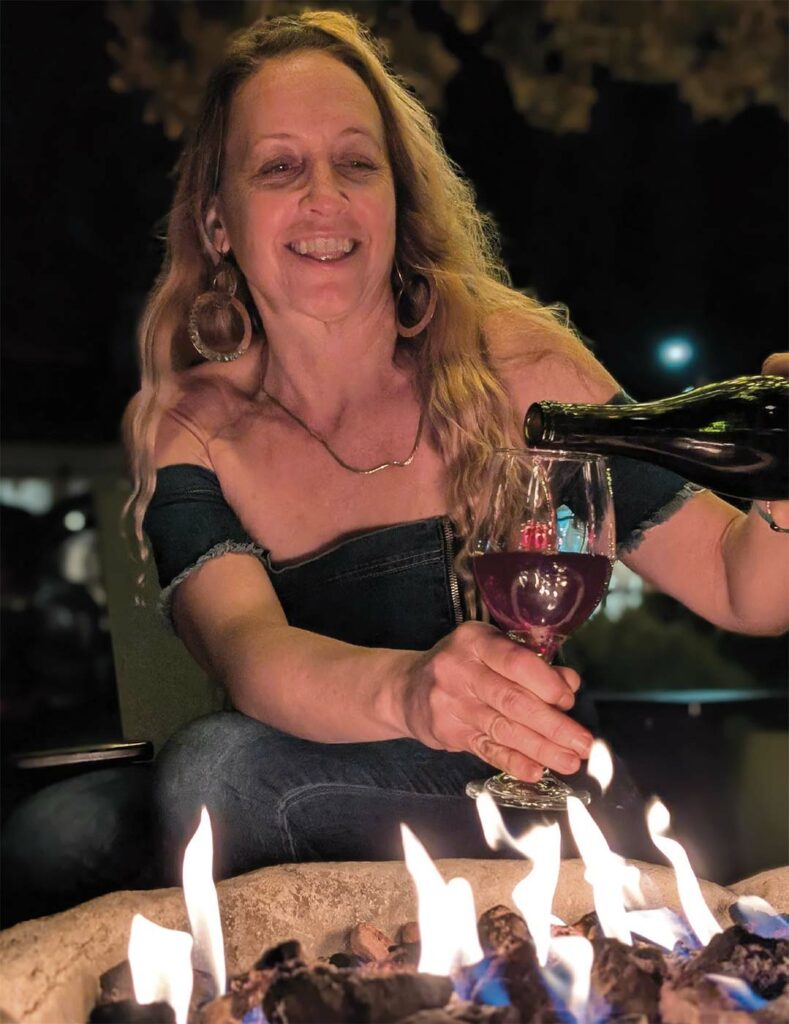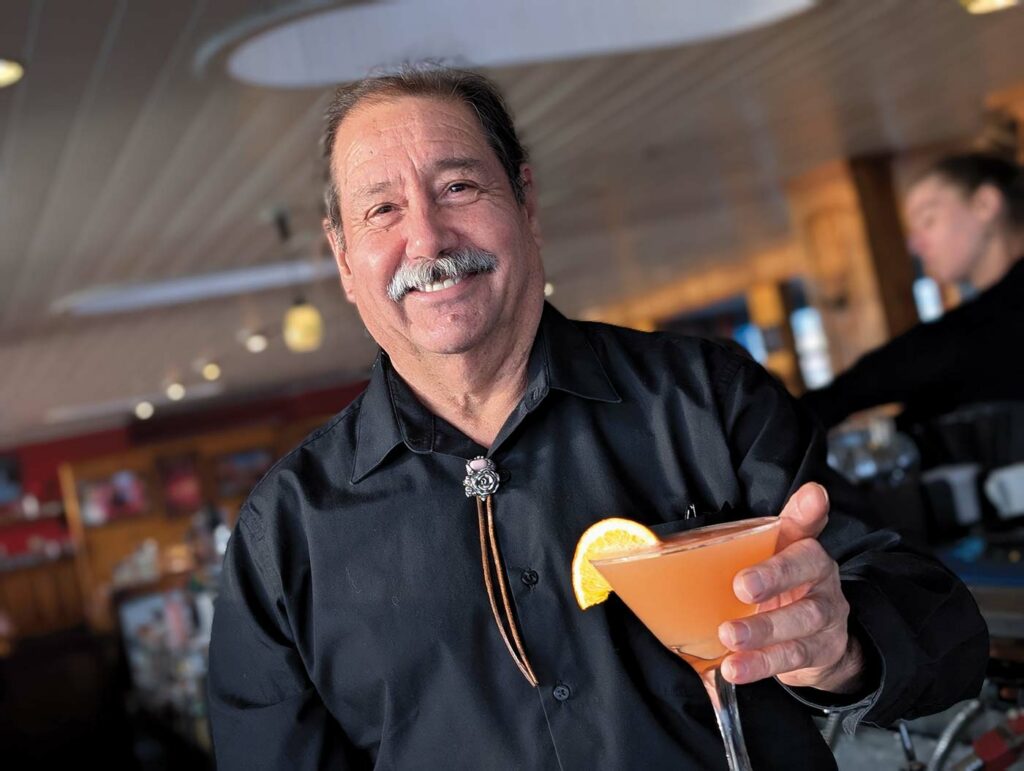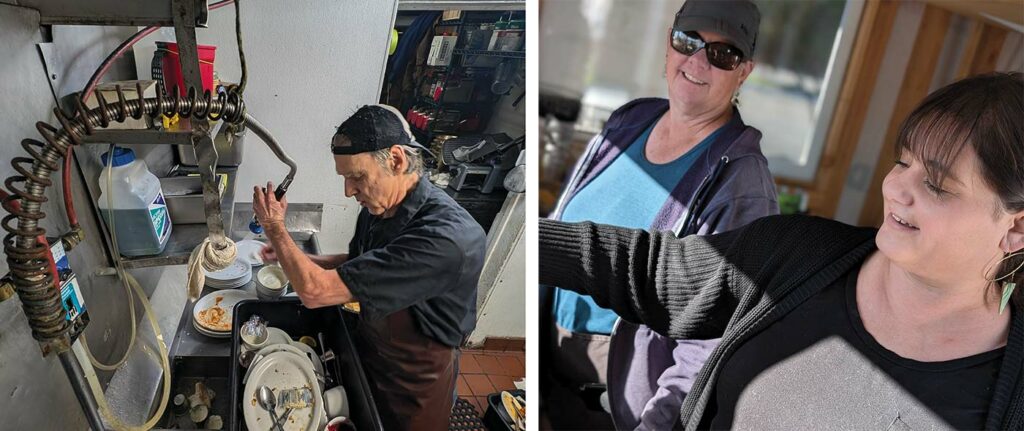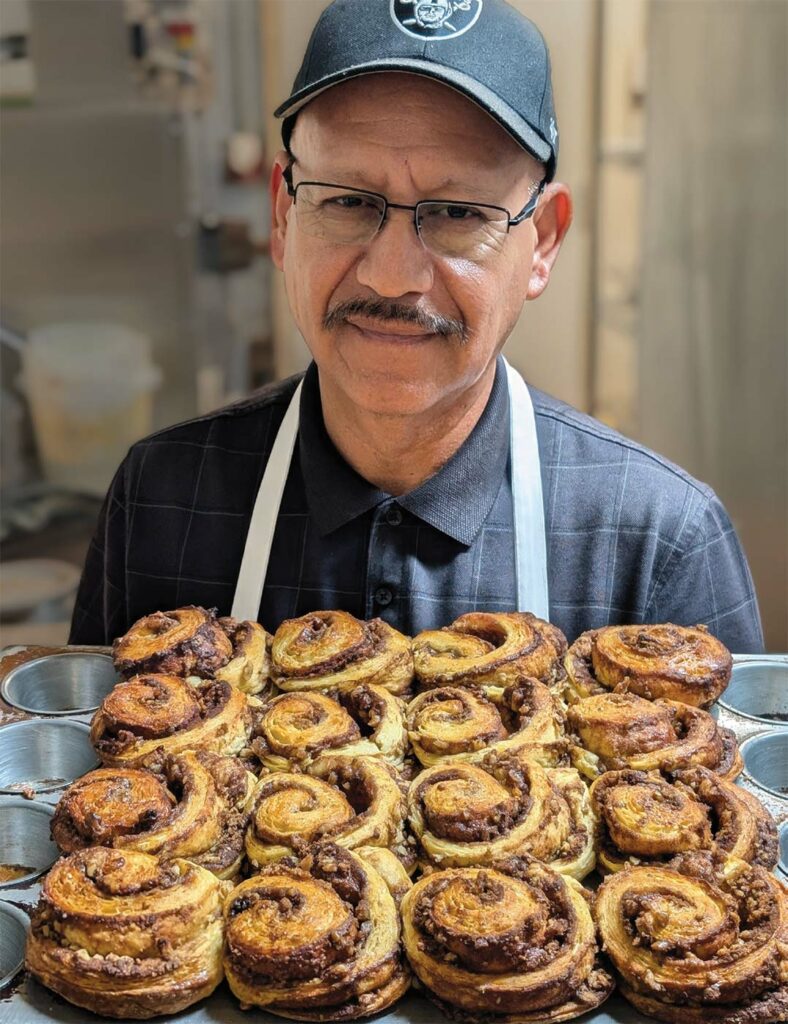
A collection of industry vets describe why they invest so much in an exhausting craft
PHOTOGRAPHY BY MARK C. ANDERSON
“After a while, I knew that if I could do this, I could do anything!”
Long before diners walk into their favorite restaurant, the work to prepare their experience begins.
Slow-simmering sauces and marinating proteins.
Washing and chopping vegetables. Baking bread.
Carving filets. Folding napkins. Setting tables. Checking reservations.
Then diners arrive for dinner—and don’t always show up as their best selves.
But the host greets them with a smile.
The server doesn’t hint at the fact her feet are aching because she’s working a double.
The line cook focuses more on rotating eight different temperature- sensitive dishes and sides, on eight different burners, rather than how little sleep he’s had.
All this has been circulating in longtime Santa Cruz restaurant worker Amy Di Chiro’s mind for a while: how a certain type of toil goes unobserved.
How it would prove challenging for a few shifts a week, let alone several decades. How taking a moment to honor that could help complete a picture dominated by flashy chefs and social media.
“If you’ve grown up in the restaurant industry, you know the people who’ve done this work for 30-plus years, and you really want to support them,” she says.
She mentions a co-worker who isn’t quite as quick as she once was, so Di Chiro would help bus a table.
“If I last that long,” she adds, “I hope younger people will do the same for me.”
Di Chiro feels the physical and mental demands of a career that, starting at 16, traversed work as a busser then server then bartender then manager. That has accumulated to the point she’s now studying to become a yogini—while still picking up shifts as a bartender.
Her experience also inspired her to suggest Edible Monterey Bay spotlight some of the lifers who make readers’ favorite restaurants go. And when she learned I had the same hope to focus on the less-heralded grinders, the day-in/day-outers, who work just as much time as the celebrated chefs with little of the attention, she invited her restaurant peers to nominate worthy workers.
She knows on a personal level what compels hospitality souls to invest in others’ happiness.
“You can change someone’s day,” she says. “They come walking in on a C- day, and we’re going to get you up to a B+.”
But an optimistic attitude doesn’t complete the skill set needed to survive in an industry most every person experiences but only a fraction understand.
Di Chiro lived through a real-time dose of that on her first day serving at Aldo’s Harbor Restaurant, when the manager quit, and Di Chiro had to take over.
“It was the most intense job ever—you’re responsible for everything.” she says. “People text you in the middle of the night about scheduling. If someone can’t come in, you have to fill in the gaps. You sweep the floor, pour iced tea. Burners go out. Dishwashers break.
There’s an altercation at the host stand because someone’s pissed that they’ve had to wait too long.
“After a while, I knew that if I could do this, I could do anything!”
But even that empowerment encountered fresh challenges over the past five years. Di Chiro notes menu prices and housing rent rates rising faster than minimum wage, putting multiple layers of pressure on staffers.
“These have been challenging times.,” she says. “It used to be you could pay your $450 rent. But life is hard now [and] COVID’s made a real shift for people—a lot more folks are struggling when they come in and sit down at a table.”
After she sought input on inspiring restaurant lifers on social media, the following five were each recommended—and, as it turns out, happen to work at some of Santa Cruz’s time-honored institutions, a hint at how those spots remain favorites.
“Burners go out. Dishwashers break. There’s an altercation at the host stand because someone’s pissed that they’ve had to wait too long.”

A LEGEND LIVES
When still a bar back, Randall Malley says he learned to keep his eyes, ears and memory banks open.
“When you’d hear someone order a drink you didn’t recognize— no cell phones back then—you had to have really good [recall] to make that drink.”
His gift for that provides one peek into how he’s become the beloved and revered bartender he is today—colleagues report they can’t go a shift without a patron asking about Malley—more than 40 years since he began in the craft.
Malley started growing his fan club shortly after the Catalyst moved from its original location to lower Pacific Avenue, when he began as a busser, before moving to bar back, then bartender.
“Depending on the band playing on a particular night, there would be different drinks asked for, meaning you had to know a lot of drinks,” he says.
This was the mid-80s, when the economy was recessing and his kids had just been born. While his following remembers him for great energy and mixology, he recalls pulling straws to see who would get to work, and taking on a second gig at the Santa Cruz Yacht Club to survive.
He ultimately tended bar at the Catalyst for 27 years, even as it meant relentless shifts and getting home at 3 or 4 in the morning. His daughter, Jessica, is a bartender—and a jewelry maker—just like Dad.
“Working at the Catalyst, I don’t know how he did it—it’s intense,” she says. “You’ve got 800 people every night, the artists with all their needs [and] it’s so loud that you have to learn how to read lips, creating lists in your mind 10 things deep to be more efficient.”
While at the Catalyst, Malley also started taking on even more shifts at Olitas Cantina & Grille on the wharf—where he anchors bar service today—on top of work at storied Henflings in Ben Lomond, juggling shifts and job offers, but never needing to fill out an application.
His reputation earned him each opportunity.
“In his whole career,” his daughter says, “I can only think of five days that he’s taken off.”
Malley shrugs and articulates a reality for many in the local industry. “Just living in Santa Cruz, it’s so expensive,” he says. “It’s hard not to work all the time.”

CLEAN FEELING
George Dorian washes dishes at The Crêpe Place up to six nights a week, as he has since 1986.
“I think I’m finally getting the hang of it,” he says, asking if he can keep stacking, scrubbing, rinsing and repeating rather than stop for a portrait.
The quantity of hours, let alone dishes, piled up over what amounts to 300 shifts a year for nearly 40 years, doesn’t seem to faze him.
“If that’s impressive, I don’t know,” he says. “It’s a good place to work.” What Dorian liked about the job decades ago keeps him there still. “It’s the people. They trust me to do the job,” he says. “How I do it is up to me. No one’s breathing down my neck.”
Dishwashing isn’t for everyone—but something about it works for a wiry, high-energy guy, who even in conversation prefers not to settle in, staying in motion, shifting his weight from one foot to the other. “I really enjoy being able to physically move, to keep in shape, and I’ve got a total system dialed in at the back of my mind,” he says. Routine becomes ritual. Chaos becomes calm.
“I just kind of Zen out,” he says. “I’ve done it like a billion times, but still dishwashing is rewarding. I feel a sense of duty in getting the dishes clean.”
After punching out at 10pm, Dorian has dinner and takes a little nap. Then he turns to his second line of work—as a musician.
“I put down grooves and jazz tracks using a synthesizer and then play guitar over them,” he reports, adding he does this all night long, tucking himself in about 9am.
Last summer, Dorian had his first bout with COVID, and was surprised how much he enjoyed having a block of time away from work to devote to his music.
At 67, he says, “I may just be inclined to give more time to music.”
REDEFINING “LIFER”
Liz Baumhefner, a dark-haired woman with a bright smile and buoyant vibe, doesn’t register as a veteran of the restaurant business. After all, she’s 30.
But so much for assumptions. Baumhefner began bussing at Aldo’s as soon as she was able to get a work permit, when she was 14.
“I liked having my own money to buy the things I wanted,” she says. One could say that not only was Baumhefner, now an experienced server, born into this line of work, but predated that; her mom, Kim Baumhefner, was pregnant with Liz while a server there.
Many Aldo’s patrons see Kim, a light-haired and reserved counterpoint to her daughter, as the face of the restaurant, Liz included.
“People come in and, if they have to, they’ll wait to get a table in my mom’s section,” Liz says.
Part of mom’s magnetism speaks to the art lost on many modern day peers: Kim Baumhefner is a listener who remembers the locals, knows if they want full-strength or decaf, the usual or tend to mix it up.
She also loves the sense of welcomeness people feel at the restaurant, and that she’s a part of helping them feel that way.
“There’s a big community at the [Santa Cruz] Harbor, lots of people to wave at, including dogs and even [pet] donkeys walking by!”
The gig at Aldo’s gains complexity not experienced at most restaurants. After its original home—in a refurbished tackle shop with a wide and always-crowded harborside deck—was destroyed by storms, it relocated to a “pop-up” spot next to the harbor that’s become permanent.
The bustle of each morning includes lugging everything out to transform the space into a restaurant—tables and chairs, condiments, napkins, and then, at the end of the day, break it down, while the sea air does nothing good for the computers, and occasional winds whip menus and napkins around.
“You’ve gotta wear a hat, but I love being outdoors, and I’m not sitting at a desk all day,” Kim says. “It’s not a bad office, that’s for sure!”
That unique setting, combined with popular breakfasts, house-made Italian “fugasa” bread and signature fried calamari— and staff that feels, appropriately enough, like family—make Aldo’s an institution. When asked what it’s like working as mother and daughter, the two women look at each other, raise their eyebrows and laugh.
With a twinkle in her eye, Kim says, “If someone comes in who I don’t like, I send them to Liz’s section!”
Liz laughs, then adds, “We get to see each other more than we otherwise would. Really, we have each other’s backs.”
“I have friends who say, ‘I hate my job’—but I love my job,” Bernardo Ramírez says. “When people say, ‘I love your food,’ I feel happy.”

KEEP IT GOING
Given the chance to put his feet up, Bernardo Ramírez, Linda’s Seabreeze Cafe head chef and kitchen manager, would rather not.
“Mostly, I work all the time,” he says. “When the restaurant closes for a few days, like over Christmas, I get bored. My wife says, ‘Take a rest.’ I say, ‘No, I’m going outside to sweep.’”
Most of us, given the chance, would pull up a chair, but this guy is a doer. He likes to be useful, to make things better than they were.
Ramírez, who’s worked at Linda’s Seabreeze since Reagan was president, is a man whose zest for life comes through not only his work, but it’s also in his brown eyes, wide mustached smile, the lilt of his voice.
Within his sense of purpose and joy is his secret to life: “Everything you do, you have to do with love, and that makes it easy.”
The everything Ramírez does includes not only preparing breakfast and lunch at Linda’s Seabreeze, but working as a butcher at Shopper’s Corner, and managing the apartment complex where he’s lived since the mid-1980s.
“I love routine,” he says, but notes another aspect of his motivation. “Every day, I learn something different.”
“At Linda’s I work in the back, so mostly, I talk to my coworkers, people I see every day, but at Shopper’s, I work with the customers. Some are really nice,” Ramírez says, and delicately adds, “Others are more particular.”
Whatever energy he encounters, he strives to give them exactly what they ask for.
“My motto is to keep everyone happy,” he says. “Then they’ll come back.”
Ramírez pauses a moment, and looks into the distance before continuing.
“Sure, we sometimes have difficult days,” he says, “but when I go to my jobs, I don’t take my problems with me.”
About the author
Local author and poet Patrice Vecchione’s new book, out in time for National Poetry Month, is My Shouting, Shattered, Whispering Voice: A Guide to Writing Poetry & Speaking Your Truth.
- Patrice Vecchionehttps://www.ediblemontereybay.com/author/patricevecchione/
- Patrice Vecchionehttps://www.ediblemontereybay.com/author/patricevecchione/
- Patrice Vecchionehttps://www.ediblemontereybay.com/author/patricevecchione/
- Patrice Vecchionehttps://www.ediblemontereybay.com/author/patricevecchione/


